Article author: Karen Shen Article translation: Block unicorn
In this article, we will explore the potential opportunities for cooperation between cryptocurrency and consumer-grade AI (artificial intelligence). This article is divided into three parts:
Why choose encryption x consumer-grade AI?
Overview of the Traditional Consumer AI Market
Opportunities of Crypto x Consumer AI
Why Crypto x Consumer AI
Over the past year, the intersection of AI and cryptocurrency has become a hot area of consumer attention, and this trend has driven the launch of a large number of new projects. The vast majority of attention and capital are focused on the infrastructure level of AI, such as computing power, training process, reasoning technology, intelligent agent models, and data infrastructure.
While many of these projects are ambitious and could lead to large-scale results, the technology is not yet production-grade (yet) and is less likely to be widely commercialized in the short term. This leaves a gap in the market for more directly impactful technology applications, especially at the consumer level.
Consumer-grade AI refers to AI products designed for everyday users rather than enterprise or business-specific applications. These products include AI-powered general-purpose assistants and recommendation systems, generative tools, and creative software. As AI technology rapidly advances, consumer-grade applications are becoming more intuitive, personalized, and easier for average users to use.

Today’s Popular Consumer AI Applications
Unlike enterprise AI, which typically requires precision and deterministic results, consumer AI benefits from flexibility, creativity, and adaptability—precisely where AI is currently excelling.
While still in its early stages, the marriage of crypto and consumer AI is undoubtedly a fascinating topic. It’s rare to see two technologies move toward maturity at the same time, so it’s worth exploring—even if the results are difficult to predict.
In the crypto space, there is a pressing need for more consumer-facing applications that provide new and interesting ways to interact with the underlying technology. Over the past decade, blockchain investments have driven significant infrastructure advances, including faster block generation, lower gas fees, better user experience (UX), and a significant reduction in user entry barriers that were common just a few years ago.
You only need to try joining apps like Moonshot, which allows you to instantly buy Meme coins using Apple Pay, to get a glimpse of how far the industry has come. However, there is still a lack of founders and developers willing to solve interesting consumer crypto problems.
At the same time, consumer-grade AI is market-ready, providing a ripe opportunity for developers to combine the two technologies to build applications that shape the way we interact with, own, and engage with digital assets and AI systems.
TraditionalConsumerAIMarket Overview
First, let’s use two resources to help us quickly understand the experiments within the traditional (non-crypto) consumer AI space:
a16z’s Top Consumer Products by Web Traffic
This report from a16z ranks the most visited consumer AI web pages and mobile apps every six months by analyzing web traffic data for consumer AI products.
By analyzing this data, they identified trends in how consumers are actively engaging with consumer AI technology, which categories are gaining traction, which categories are declining, and the early leading projects in each category.
Below are the top 100 consumer AI products as of August 2024, broken down by category into web and mobile apps.
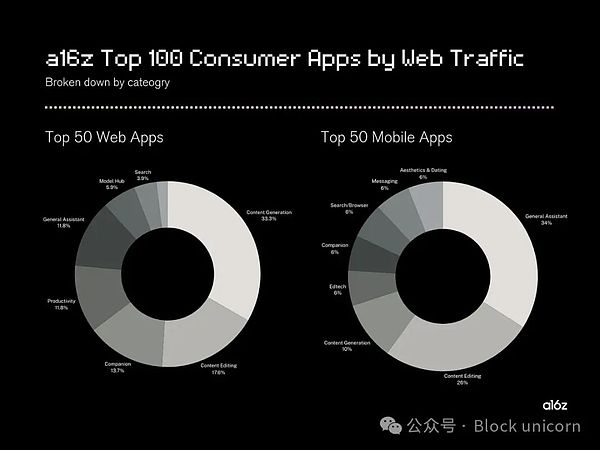
Clearly, content generation and editing tools are leading the way in the consumer AI space.
These apps now account for 52% of the top 50 web apps and 36% of the top 50 mobile apps. Notably, this category is expanding from text-generated images to include video and music generation, further expanding the potential for AI-driven creative expression.
Popular categories like general assistants, companion tools, and productivity tools remain stable in the top 100 list, reflecting continued demand. A new category, "Aesthetics & Dating," was added to the third edition of the a16z report, with three projects in this category making the list.
It is worth mentioning that a cross-category crypto project also made the list. Anime companion app Yodayo (now Moescape AI) ranked 22nd on the web app list.

Moescape AI
Comparing a16z’s latest report to previous reports, we can see that while the categories of core consumer AI remain stable, about 30% of the top 100 projects are new, highlighting the continued development of the field.
YC Team’s Latest W24 Project Batch
Next, let’s review YC’s W24 project batch (latest version) as a resource to help identify emerging consumer AI projects and categories that, while already in the market, may not have enough traction to appear in a16z’s top 100 page traffic list.
The idea here is that despite uncertainty about actual consumer demand for these products, this information can help us predict consumer AI trends over the next 6-12 months.
Of the 235 recent projects, 63% focus on the AI space, with 70% building on the application layer. Only about 14% of application layer projects are identified as consumer-centric.
The following is our attempt to categorize consumer AI projects.
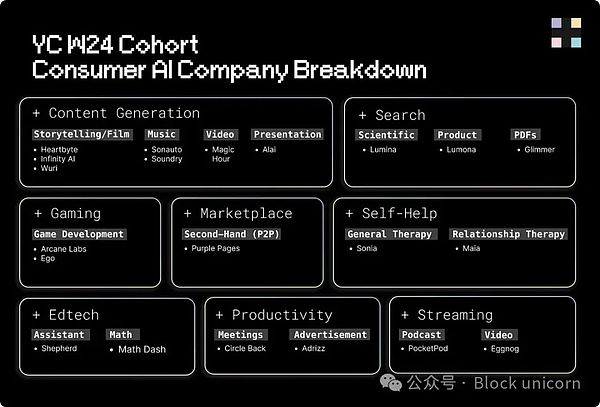
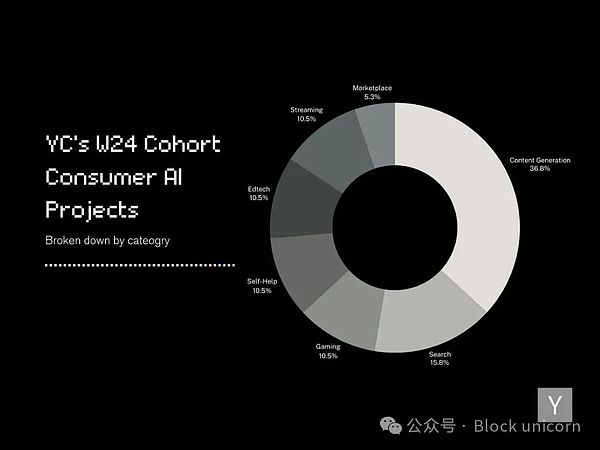
Similarly, content generation remains the most popular category among founders, with new projects pushing the boundaries of creative possibilities.
Similar to trends in the a16z report, YC's latest batch of entrepreneurs are exploring advanced content types, including storytelling, script-to-film generation, music, video, and presentation-focused content.
In addition to content generation, founders are also focusing on search, productivity, and education technology. These three categories are consistent with the a16z report, although most of the companies in YC are developing more targeted, vertical-specific solutions in these areas.
Finally, categories like gaming, automation, marketplaces, and streaming appear in this group, signaling some new directions that don’t appear in the a16z report.
The Crypto x Consumer AI Opportunity

Now that we’ve covered background trends in the traditional consumer AI market, let’s turn our attention to consumer crypto AI.
First, it may be helpful to briefly describe how AI can be useful for crypto products, or how crypto can be useful for consumer AI products.
Crypto and AI offer very different value propositions.
Arguably, the values of the two technologies clash — crypto focuses on decentralization, privacy, and individual ownership, while AI tends to concentrate power and control in the hands of those who develop and own the most advanced models.
However, with the advent of decentralized and open-source AI, these lines are beginning to blur.
The core innovation of AI in consumer products is to mimic and extend human creativity by generating novel content, while learning from massive data sets, modeling complex relationships and producing high-quality output using advanced neural network architectures.
Early signs suggest that AI applications show strong user retention and monetization potential. However, they also face a “tourist problem” where user traffic is high but conversion rates from free to paying users are lower than usual.
On the other hand, crypto is a design space that encompasses decentralization, cryptoeconomic incentives, and hyper-financialization. It is a distributed ledger that allows the value of any digital object to be stored in a transparent and traceable manner.
Crypto is highly effective at coordinating activity, aggregating decentralized infrastructure, and creating frictionless markets, making it easy to create markets where none existed before. However, crypto has yet to build a compelling and sustainable consumer application outside of financial infrastructure.
AI could be one of the key factors in unlocking crypto’s broader consumer potential. A recent study highlights the rapid adoption of generative AI, which has surpassed PCs and the Internet—with approximately 32% of U.S. residents using AI on a weekly basis. Given this pace, developers of consumer crypto are well-positioned to experiment and innovate in tandem with the accelerated adoption of AI.
We believe breakthrough results will emerge through innovative consumer applications that combine the power of AI with the unique capabilities of decentralized and financialized networks enabled by crypto.
Market Overview
The number of consumer-focused projects operating at the intersection of crypto and AI is still relatively small, with our research estimating around 28, although this is not a final number.
In this crowdsourced decentralized AI market map, the consumer-grade category only accounts for ~13% of the total decentralized AI market, indicating that we still have a lot of room to grow. As a quick comparison, ~60-70% of the products in the technology market are at the application layer, with ~70-80% of these being consumer-facing applications.
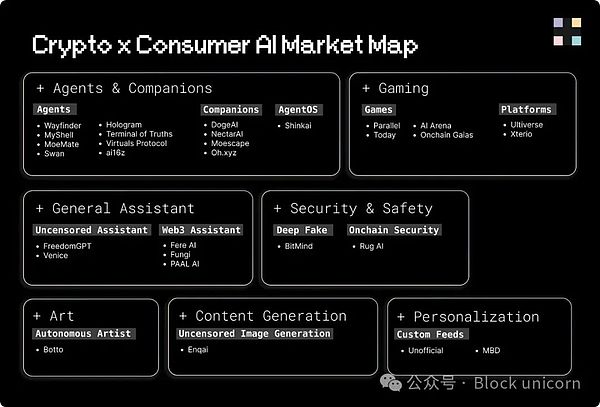
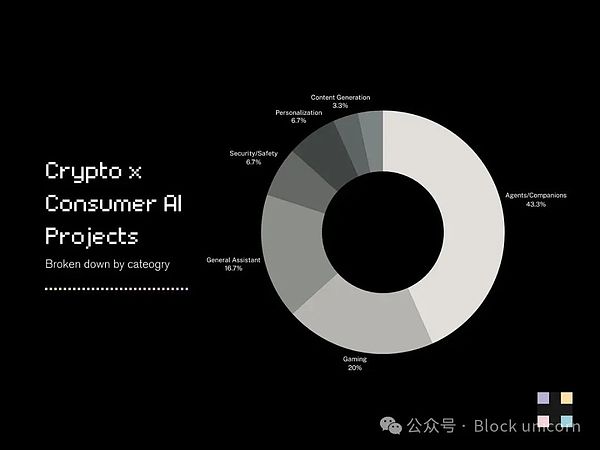
While we only covered a small subset of projects in this report, we were able to identify some early insights.
We have identified some early thinking from teams as they integrate crypto and AI. These insights have been distilled into several broader use cases below, some of which show potential while others may be less sustainable.
Incentive Mechanisms: Cryptocurrency as a way to incentivize and reward user activity on AI platforms/applications. For example, one use of the Wayfinder native token is to reward agents and participants for creating valuable on-chain paths for AI agents as they walk on-chain. For Botto, automated AI artists ask their community for feedback on their art creations. Botto rewards this participation by distributing a portion of their artwork sales in the form of $BOTTO tokens.
Financialization: The ability to trade, own, and generate income from AI assets on the blockchain. For example, Virtuals Protocol provides a platform where anyone can buy, own parts of AI agents, and benefit from the income generated by AI agents they trust. Ownership is represented in the form of tokens.
Vesting: Allowing intellectual property holders to track, verify, and claim royalties on the blockchain. For example, censorship-resistant companion projects like Oh.xyz are using cryptography to create digital twins of creators on their platform as a way to verify the authenticity of content and claim royalties in the future.
In-app or in-game economy: Cryptocurrency as in-app/in-game currency. For example, games like Parallel and Today will have in-game economies where players and their AI agents will be able to trade resources using their respective tokens.
Decentralized: Decentralized networks, services, and models. For example, BitMind is a subnet on Bittensor that is building the first decentralized deepfake detection system. Using Bittensor, they are able to encourage open competition between AI developers to contribute to building the best deepfake detection model.
Censorship resistance: Remove censorship from generative AI content creation. For example, Venice is a private and permissionless generative AI assistant built on Morpheus’ decentralized universal agent network. Unlike traditional AI assistants, Venice does not censor the AI’s content or download your conversations.
Membership: Cryptocurrency as a means of accessing premium features. For example, MyShell’s ecosystem token has multiple use cases, one of which is to grant holders access to premium features.
Assistant: AI is a way to make interactions between people and crypto easier. For example, Wayfinder, Fere AI, Fungi, and PAAL AI are vertical general assistants or bots for the cryptocurrency industry that aim to make the crypto experience more convenient for end users.
Contextualization: AI is a way to contextualize and personalize content on the blockchain. For example, Unofficial aims to build a discovery engine for on-chain social on Farcaster using zkTLS and RAG.
After reviewing the current cryptocurrency and consumer AI markets, including the application of cryptocurrency and AI, as well as the status of established and emerging categories in the traditional consumer AI space, the following sections will explore the design spaces with the most potential in this intersection for developers to consider.
Games and Agents/Companions
There is a reason why games and agents/companions are the two most popular categories among founders in this intersection. Because they provide the most suitable environment for AI and cryptocurrency experiments.
Games and agents usually operate in fictional realms with the purpose of entertaining consumers. Their results usually do not need to be conclusive and usually have less impact on real life. Therefore, this provides perfect conditions for experimentation.

Today’s Hyper-Realistic Gaming Environment
To date, games like Parallel Colony and Today use AI as the core experience of the product, where the AI NPC characters in the game behave like real humans, have autonomy and are able to have conversations.

Cryptocurrencies are being used as financial channels for in-game payments, agent-to-agent payments, or unlocking character ownership.
Crucially, this new digital economy is an advantage these crypto games have over the multitude of AI games that are coming to market.
AI is a transformative technology that will undoubtedly be a critical part of future game development and gaming experiences - but we believe that teams that build AI games with the goal of a digital native economy will have the greatest competitive advantage.
AI agents in games are fun, but what cryptocurrencies unlock is the ability for games to introduce economic systems that replicate the human experience for the first time. NPCs in games simply cannot open their own bank accounts, conduct transactions, and make real economic decisions. As a result, many unprecedented behaviors and opportunities may emerge.
As Kalos, founder of Parallel, said on Twitter:

Today, this is best demonstrated in fictional environments such as games.
Projects building AI agents and companions have similarities in their use of AI and cryptocurrency - AI as the core experience, cryptocurrency as financial infrastructure. However, unlike agents in games that operate in a limited environment, allowing for more complex interactions and with little real-life consequences, agents and companions are currently limited to one-to-one or one-to-many relationships.
For example, with MyShell, Virtuals Protocol, or MoeMate, end users interact with AI chatbots via chat or voice functionality - the interaction is limited to you and the chatbot (or other medium). Chatbots are LLM wrappers with limited features that can be customized by the bot's creator, such as the tone of communication, the appearance of the agent, etc. As a result, your interactions with these chatbots are also limited in creativity.

MoeMate's Draco Malfoy AI chatbot experience
While similar to its competitors, ai16z takes an open-source, bottom-up approach focused on building on-chain AI agent infrastructure to provide tools for a multi-agent future.
There is still a lot to explore in both areas, such as multi-agent experiences or infinite game modes. Consumer experiences involving many-to-many AI agents interacting with humans, while complex, have the potential to lead to more dynamic and engaging interactive experiences, as well as more complex crypto-economic systems. This area remains underexplored outside of gaming environments.
We continue to believe that this is one of the areas of greatest interest to the founders, and we can't wait to see what innovations the future will bring.
General-Purpose Assistants & Content Generation Tools
General-Purpose Assistants and Content Generation Tools dominate the traditional consumer AI space. However, intense competition makes entering this market challenging and expensive, which explains why these categories are less strongly represented on crypto market maps than traditional AI.
Demand for these tools remains strong, consistently ranking at the top of a16z’s network traffic analysis. For founders at the intersection of crypto and AI, these categories remain promising, especially products tailored specifically for crypto users. By focusing on the specific needs of the crypto space, it’s possible to create unique value without having to compete in a saturated traditional market.
Here are some examples:
AI-enabled Crypto Assistants: Crypto is notoriously difficult to navigate. Whether you’re trying to buy or exchange tokens on-chain, or meet the requirements to participate in a game or social experience, there are many obstacles.
Are you on the right network? How do I switch networks? Do I have the right gas tokens? How do I transfer funds to my target network?
For newcomers, the learning curve is high. Even for those familiar with cryptocurrencies, these tasks can be time-consuming.
While the industry has largely improved on account abstraction, intents, and other UI/UX to date, AI is more likely to integrate these developments and drive these changes forward. Several teams, such as Wayfinder, Fungi, PAAL AI, and Fere AI, are already exploring solutions, although no one has made significant progress yet — leaving room for more competitors and specialization.

Wayfinder's Crypto Assistant at a Glance
Experienced Solidity developers may have different needs than newbies. We believe that teams that build with a specific user group in mind (tailoring the experience entirely to that user group's problems), provide a refined user experience (leveraging advances in account abstraction and intent), and personalized services (based on the user's previous on-chain activity) are most likely to succeed.
AI-enabled asset generation: In the crypto space, content generation can be considered asset generation. These assets can be ERC20, ERC721, ERC1155, or other standard forms of tokens and digital assets, and the ways they can be generated are almost endless. Similar to how Midjourney and DALL-E generate images, or how SUNO composes music, AI can play a key role in cryptoasset generation.
Early examples of AI-driven cryptoasset generation include Truth Terminal’s $GOAT token, Wayfinder’s asset deployment agent, Swan’s upcoming gamified asset generation marketplace, and Virtuals Protocol’s AI agent launchpad.
In addition to generating assets, AI can shape narratives, market assets, and give them a “voice.” For specific asset types like Meme coins (with no external dependencies), AI can efficiently streamline the end-to-end asset development process.
In a world where AI agents can frictionlessly generate countless cryptoassets, the opportunity for developers lies in identifying where value and attention flows. For example, the strategy taken by Virtuals Protocol is to shift speculation to the creator level, allowing consumers to predict the ability of AI agents to attract attention and create interesting assets.
We are currently in the early stages of a wild new reality where AI can generate real financial value in the form of crypto assets, and humans can enjoy and speculate on the development of these assets. While the future of this trend is difficult to predict, there is a huge space for experimentation in this area, and we will be watching closely to see where it goes.
Miscellaneous
There are many categories at the intersection of crypto and consumer-level AI that are still underexplored. With the rapid development of AI, these categories are likely to grow and evolve rapidly. While many categories may be short-lived, and there may be fewer categories that are suitable for crypto collaboration, there is still plenty of room for experimentation in this space - and we welcome it!
One way to think about this is to consider crypto equivalents of traditional consumer AI projects, especially those that don’t currently have crypto intersections. For example, we applied crypto to two categories from the a16z and YC lists, and added an additional category to explore.
Edtech is a popular consumer AI category that can benefit from crypto at different levels of the stack. Education spans regions, subjects, languages, education levels, and teaching methods. In this context, rather than taking a centralized approach, it is more useful to advance edtech through open source development with a global community of contributors. In this context, the edtech-focused subnet on Bittensor can help build these models.
Crypto can also be applied to the incentive level of edtech applications. Going beyond traditional gamification strategies (such as Duolingo’s daily streak mechanism), with crypto, teachers and students can be rewarded for their contributions and efforts on both the supply and demand sides.
For self-help, the potential of cryptocurrencies to enable data ownership and monetization could be very compelling. Due to a number of reasons, including cost, social stigma, lack of awareness, and a shortage of professionals, it remains out of reach for many people. Projects like Sonia and Maia (both recent YC incubators) are showing early signs of what is possible with affordable AI-driven counseling solutions. Traditionally, therapists’ notes are stored in paper or digital files in the office, with the data inaccessible. However, with AI therapists, the data can be stored privately online, which could unlock entirely new use cases from an individual’s mental health data.
Imagine if you could actually own the data from an AI therapy session. You could choose to keep it private, monetize it, or even anonymously contribute it to a health data network to support meaningful research. Crypto-native projects like Vana are making this possible by giving people a stake in their own data.
In the entertainment space, projects like Unlonely are experimenting with crypto-native livestreaming, where users can speculate and influence the outcome of livestreams by trading the platform’s tokens. Currently, this is limited to real-life events, but it could be expanded to AI-generated content. This could enable 24/7 livestreaming, where users have greater control over the livestream narrative. An early example that recently emerged is MineTard AI. It’s an AI agent that streams Minecraft 24/7 on Kick, and the agent can be influenced by $MTard holders.
Last year, a viral trend emerged on TikTok where creators role-played as NPCs that performed specific actions based on the “gifts” they received. While this content type was short-lived, it clearly demonstrated consumer interest in interactive livestreaming experiences. As AI-driven NPC technology advances, similar gamified interactions may be suitable for crypto-native livestreaming, where AI NPCs can respond to user input in real time.

Top NPC Trends on TikTok
These are just some rough ideas on how crypto and AI can be applied to consumer applications. We have not covered every possible application in this report, and we expect many more such innovations to emerge as the industry rapidly evolves.
Message
As you can probably tell, we are very excited about the possibilities at the intersection of crypto and consumer AI. The projects currently being built in this space represent only a small fraction of what is possible.
With the parallel development of these two technologies, founders have a unique window to create a new wave of consumer applications that could change the way we interact and engage with digital assets and synthetic intelligence.
For those of you building in this space, we encourage you to continue to push the boundaries and explore unconventional applications of these technologies. We also hope that for some of you this resource will help you on your journey.
 Anais
Anais




















